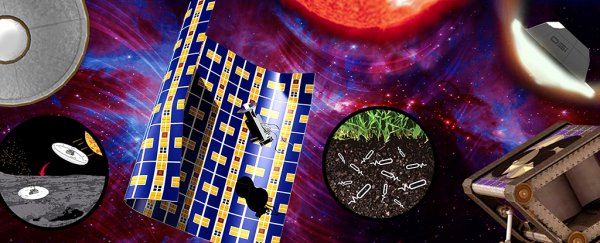Own up – how many of you still have that picture you drew when you were 10 of a tentacled-squid-bot diving the depths of Jupiter's gaseous oceans, or of a blimp sailing the skies of Titan in search of floating aliens?
NASA might prefer that it's not presented in crayon, but based on the results of its latest rounds of Innovative Advanced Concepts (NIAC) program pitches, they're willing to entertain some pretty imaginative suggestions for undergoing space exploration in the not-too-distant future.
Between 1998 and 2007, the program was known as the NASA Institute for Advanced Concepts, and was responsible for exploring cutting edge ideas that could provide clever ways to conduct its missions.
In 2011, a new version of the program was launched under the same acronym but a slightly different name, continuing to fund studies that aim to investigate exciting possibilities in space travel and exploration.
Best of all, the ideas don't need to come from NASA scientists – virtually anybody can apply, where the mix of 'so-crazy-it-just-might-work' and plain old 'so-crazy' are put through a peer review process before a final list is decided upon.
"The NIAC program engages researchers and innovators in the scientific and engineering communities, including agency civil servants," said Steve Jurczyk, associate administrator of NASA's Space Technology Mission Directorate.
"The program gives fellows the opportunity and funding to explore visionary aerospace concepts that we appraise and potentially fold into our early stage technology portfolio."
All of the proposals fall into two categories: Phase I awards pay researchers US$125,000 to define and analyse the feasibility of their idea; in Phase II, researchers can be awarded up to US$500,000 to take their Phase I idea and spend the next two-years studying it further.
The list of past ideas reads like the index from an encyclopaedia of science-fiction, with printable spacecraft, asteroid-mining robots, and 'torpor inducing transfer habitats' to help astronauts sleep all the way to Mars.
The entries for 2017 are just as much fun to read. You can read the full list here.
This year's 15 Phase I ideas include:
- Synthetic biology to detoxify and enrich Martian soil for agriculture
- Vacuum-filled airships for evacuating Mars missions
- Hopping, skipping, jumping Pluto landers
- A high-speed magnetic propulsion system
- Highly reflective heat-protective coating to allow a probe to skate close to the Sun
The past Phase I proposals to get the nod for seven new Phase II projects this year include:
- A rechargeable probe that can drift through the clouds on Venus on a balloon
- Mining minerals from asteroids by blasting it out with concentrated sunlight
- A direct fusion drive to push 1,000 kilograms of lander and orbiter to Pluto in just four years
"Phase II studies can accomplish a great deal in their two years with NIAC. It is always wonderful to see how our Fellows plan to excel," said NIAC program executive Jason Derleth.
Not all of the projects will turn out to be useful, useable, or even feasible, and even those that seem to have some merit could take years, if not decades to find a place in NASA's missions.
But it's not really the point. Even failure will push future ideas into directions never considered possible, providing data that could find a place in more Earth-grounded innovation.
"Hopefully, they will all go on to do what NIAC does best – change the possible," said Derleth.
If you think your brain-wave is worth funding and want to apply for future rounds, you will need to have a US citizen or somebody working in the US on your team; otherwise, get out your crayons!
Just stay on the look-out for that tentacled-squid-bot in next year's list!
